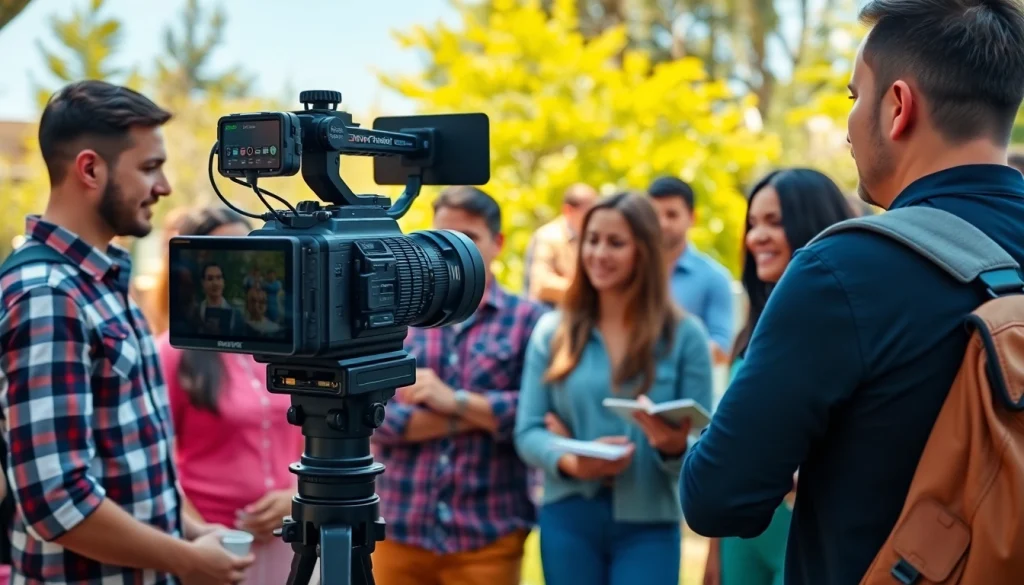
Understanding On-Site Videography
What is On-Site Videography?
On-Site Videography refers to the practice of capturing video content in real-world locations rather than in a controlled studio environment. This approach allows videographers to incorporate the authentic atmosphere, scenery, and elements of live events, training sessions, or corporate disquisitions into their footage. From conferences and seminars to documentary-style storytelling, on-site videography enables businesses and individuals to create engaging visual narratives that resonate with viewers. Utilizing the natural setting brings forth not only aesthetic appeal but also context that enhances the storytelling experience.
The Importance of On-Site Videography for Businesses
In today’s digital landscape, visuals play an essential role in marketing strategies. On-Site Videography serves as a powerful tool for businesses aiming to build brand awareness and effectively communicate their message. By opting for on-site videography, organizations can not only showcase their products and services but also convey their values, culture, and mission. This authenticity captures the audience’s attention and fosters connections, making it a vital component of any successful marketing campaign.
Key Benefits of On-Site Videography
On-site videography offers numerous advantages that can significantly impact a business’s bottom line:
- Authenticity: Capture genuine moments in real environments that resonate with viewers.
- Flexibility: Adapt to various shooting conditions and manipulate natural elements to enhance visual storytelling.
- Cost-effectiveness: Reduce the need for elaborate set designs and studio fees, while leveraging existing locations.
- Engagement: Create dynamic content that engages viewers on multiple levels, boosting viewer retention and response rates.
- Brand Positioning: Position your brand as an industry leader by showcasing expertise in real-world scenarios.
Essential Techniques for Effective On-Site Videography
Planning and Pre-production for On-Site Videography
Successful on-site videography begins long before the cameras start rolling. Effective planning and pre-production are critical in creating a cohesive product. Key steps include:
- Define Your Goals: Establish clear objectives for your video. Is it to inform, entertain, or educate your audience?
- Scout Locations: Visit each site where filming will occur to identify optimal shooting angles, lighting conditions, and sound considerations.
- Develop a Storyboard: Create a visual outline that maps out the shots needed to tell your story effectively, including key scenes and transitions.
- Schedule Wisely: Take into account the timing of events and location availability to engage participants without disruptions.
- Gather Resources: Ensure all equipment, crew, and talent are ready and aware of their responsibilities during the shoot.
Camera Techniques for Captivating On-Site Videography
Understanding camera techniques is crucial in producing visually stunning videography that captures the audience’s interest. Key elements include:
- Framing: Utilize the rule of thirds for more engaging compositions, ensuring that subjects are placed at key intersection points.
- Movement: Incorporate camera movements such as pans, tilts, and dolly shots to add dynamism and keep viewers engaged.
- Depth of Field: Use shallow depth of field to focus on the subject while blurring out distractions in the background.
- Angles: Experiment with different angles and perspectives to present subjects in a unique light, adding variety to your footage.
- Lighting: Leverage natural light where possible, and employ reflectors or diffusers to enhance lighting quality and create the desired mood.
Editing Techniques to Enhance On-Site Videography
Once filming is complete, skilled editing will bring your on-site videography to life. Effective techniques include:
- Story Arc: Construct a compelling narrative structure that guides the viewer through a clear beginning, middle, and end.
- Transitions: Employ smooth transitions to maintain flow between shots, using fades, cuts, or wipes as appropriate.
- Color Grading: Use color correction and grading to enhance the mood and feel of your footage, creating a polished final product.
- Sound Design: Incorporate sound effects and background music to add depth, context, and emotional cues to your video.
- Text and Graphics: Add titles, lower-thirds, and graphics to provide information and reinforce key messages throughout the video.
Equipment Checklist for On-Site Videography
Must-Have Cameras for On-Site Videography
The camera used can significantly affect the quality of your on-site videography. Here are some options worth considering:
- DSLR Cameras: Versatile and capable of delivering high-quality video with the option for interchangeable lenses.
- Mirrorless Cameras: Compact and lightweight with excellent video quality and autofocus features suitable for dynamic environments.
- Camcorders: Offer built-in stabilization and user-friendly interfaces designed to facilitate long shoots.
- Action Cameras: Ideal for capturing innovative angles and fast motion, perfect for documenting outdoor events and activities.
Audio Equipment for Optimal On-Site Videography
Audio quality can make or break your videography project. Here are important audio equipment recommendations:
- Lavalier Microphones: Small and inconspicuous, ideal for capturing dialogue clearly during interviews and presentations.
- Shotgun Microphones: Directional mics that capture sound from a specific source while minimizing background noise.
- Field Recorders: Provide high-quality audio capture that can be synced with video during the editing process.
- Windshields: Essential for outdoor shooting to reduce wind noise and enhance audio clarity.
Lighting Gear for On-Site Videography Success
Proper lighting is crucial for enhancing your on-site videography. Consider these essential lighting gear:
- LED Panels: Portable and energy-efficient, providing adjustable lighting for various shooting conditions.
- Softboxes: Distribute light evenly, reducing harsh shadows and creating a soft glow.
- Reflectors: Utilize reflective surfaces to bounce light onto subjects and illuminate areas lacking natural light.
- Portable Lights: Battery-operated options are valuable for quick setup in outdoor or remote locations.
Common Challenges in On-Site Videography and How to Overcome Them
Dealing with Unpredictable Weather Conditions
Weather can be a significant factor in outdoor videography. Here are strategies to adapt:
- Plan for Contingencies: Always have a backup location or alternative shooting date available.
- Weatherproof Equipment: Invest in protective gear and covers for your cameras and microphones.
- Adjust the Schedule: Be flexible with your shooting schedule to accommodate changing conditions.
- Utilize Natural Light: Leverage overcast conditions for softer lighting or sunset for warm tones.
Managing Audio Quality During On-Site Videography
Maintaining sound quality poses unique challenges in varied environments. Combat these issues by:
- Monitoring Sound Levels: Constantly check audio levels using headphones to ensure clarity and minimize distortion.
- Avoiding Noisy Locations: Scout locations ahead of schedule to identify and mitigate potential disturbances.
- Placement of Microphones: Position mics strategically to capture clear dialogue while reducing background interference.
- Testing Equipment: Perform sound tests before recording to troubleshoot and adjust settings if necessary.
Overcoming Spatial Limitations in On-Site Videography
Working within small or confined spaces can restrict your shot options. To overcome these limitations:
- Use Wide-Angle Lenses: Maximize your field of view and gather more context within tight settings.
- Plan Shot Sequences: Create a detailed shot list to ensure efficient use of space without disrupting the event.
- Minimize Foot Traffic: Keep crew members and equipment organized to maximize available shooting space.
- Leverage Vertical Space: Use different camera heights to gain unique perspectives that might not rely on wide areas.
Measuring Success in On-Site Videography Projects
Evaluating Viewer Engagement with On-Site Videography
To determine the effectiveness of your videography, evaluating viewer engagement is paramount. Metrics to assess include:
- View Counts: Track the total views to gauge initial interest in your content.
- Watch Time: Analyze how long viewers remain engaged to understand content retention.
- Interaction Rates: Monitor likes, shares, and comments to gauge audience response and engagement.
- Conversion Metrics: Measure actions taken as a result of watching the video, such as sign-ups, purchases, or inquiries.
Analytics Tools to Track On-Site Videography Performance
Implementing analytics tools is essential for gaining insights into your videography’s performance. Popular options include:
- YouTube Analytics: Offers in-depth video performance metrics, including audience demographics and interest peaks.
- Google Analytics: Analyze traffic sources and user behavior on your site post-video engagement.
- Social Media Insights: Leverage built-in analytical tools on platforms like Facebook or Instagram to measure post-performance.
- Survey Tools: Collect feedback directly from viewers regarding their perspectives on the video content.
Gathering Feedback for Continuous Improvement in On-Site Videography
Feedback is critical for refining future projects. Consider the following methods to gather insights:
- Creations of Post-Project Surveys: Send out questionnaires to viewers and stakeholders to collect opinions and suggestions.
- Engaging in Community Discussions: Foster dialogues with your audience through social media to gather real-time thoughts.
- Hosting Focus Groups: Assemble select viewers to review the footage and discuss their viewpoints in detail.
- Post-Event Meetings: Conduct internal reviews with team members to identify areas of strength and opportunities for improvement.





